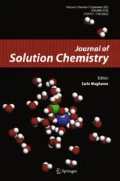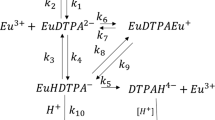Abstract
The solvent extraction method involving diglycolic acid (dicarboxy methyl ether) as a competitive ligand to lutetium and N-tris[hydroxymethyl]methyl-2-aminoethanesulfonic acid (TES) as a buffer was used to study the hydrolysis of lutetium in 1 mol⋅dm−3 NaCl ionic strength at 303 K. Acid dissociation constants of H2DG and TES were determined and the possible formation of lutetium–TES compounds was investigated. It was found that lutetium does not form compounds with TES under the experimental conditions. The solvent extraction method using 177Lu as a tracer was applied and the first hydrolysis constant of lutetium was determined by means of the relationship of the equilibrium constant of the complex Lu(DG)+ in the absence and in the presence of hydrolysis. The value obtained was log 10 β Lu,H=−7.9±0.3.
Similar content being viewed by others
References
Frolova, U.K., Kumok, V.N., Serebrennnikov, V.V.: Hydrolysis of ions of the rare earth elements and yttrium in aqueous solutions. Izv. Vysshikh Uchebn. Zavedenii Khim. Khim. Tekhnol. 9, 176–179 (1966); Chem. Abstr. 65, 9816c (1966)
Guillaumont, R., Désiré, B., Galin, M.: Première constante d’hydroyse des lanthanides. Radiochem. Radioanal. Lett. 8, 189–198 (1971)
Usherenko, L.N., Shorik, N.A.: Hydrolysis of rare earth metal, yttrium, scandium and thorium ions in water and in water–ethanol mixtures. Russ. J. Inorg. Chem. 17, 1533–1535 (1972)
Ramírez-García, J.J., Solache-Ríos, M., Jiménez-Reyes, M., Rojas-Hernández, A.: Solubility and hydrolysis of La, Pr, Eu, Er, and Lu in 1M NaCl ionic strength at 303 K. J. Solution Chem. 32, 879–896 (2003)
Baes, C.F. Jr., Mesmer, R.E.: The Hydrolysis of Cations. Wiley, New York (1976)
Martell, A.E., Smith, R.M.: Critical Stability Constants. Plenum, New York (1977)
M’Halla, J., Chemla, J., Bury, R., David, F.: Étude conductimétrique de l’hydrolyse des ions lanthanides dans l’eau. J. Chim. Phys. 85, 121–133 (1988)
Mohapatra, P.K., Khopkar, P.K.: Hydrolysis on actinides and lanthanides: Hydrolysis of some trivalent actinide and lanthanide ions studied by extraction with thenoyltrifluoroacetone. Polyhedron 8, 2071–2076 (1989)
Khopkar, P.K.: (unpublished work) cited in Ref. [19] of Mohapatra, P.K., Khopkar, P.K., Polyhedron 8, 2071–2076 (1989)
Klungness, G.D., Byrne, R.H.: Comparative hydrolysis behavior of the rare earths and yttrium: The influence of temperature and ionic strength. Polyhedron 19, 99–107 (2000)
Tuck, D.G.: A proposal for the use of a standard format for the publication of stability constant measurements. Pure Appl. Chem. 61, 1161–1163 (1989)
Choppin, G.R., Mathur, J.N.: Hydrolysis of actinyl(VI) cations. Radiochim. Acta 52/53, 25–28 (1991)
Jiménez-Reyes, M., Solache-Ríos, M.: The first hydrolysis constant of Eu(III) in 4 M ionic strength at 303 K. Radiochim. Acta 64, 201–203 (1994)
López-González, H., Jiménez-Reyes, M., Rojas-Hernández, A., Solache-Ríos, M.: Determination of the hydrolysis and carbonate constants of Pr(III) in 2M NaCl ionic strength at 303 K. Talanta 44, 1891–1899 (1997)
Caceci, M.S., Choppin, G.R.: The determination of the first hydrolysis constant of Eu(III) and Am(III). Radiochim. Acta 33, 101–104 (1983)
Grenthe, I., Tobiasson, I.: Thermodynamic properties of rare earth complexes. I. Stability constants for the rare earth diglycolate complexes. Acta Chem. Scand. 17, 2101–2112 (1963)
Caceci, M.S., Choppin, G.R.: An improved technique to minimize cation adsorption in neutral solutions. Radiochim. Acta 33, 113–114 (1983)
Lederer, M.C., Hollander, J.M., Perlman, I.: Table of Isotopes. Wiley, New York (1968)
Charlot, G.: Chimie analytique quantitative, vol. II, p. 536. Masson et Cie, Paris (1974)
Fritz, J.S., Oliver, R.T., Pietrzik, D.J.: Chelometric titrations using an azoarsonic acid indicator. Anal. Chem. 30, 1111–1114 (1958)
Snoeyink, V.L., Jenkins, D.: Química del agua, p. 487. Limusa, México (1990)
Gans, P., Sabatini, A., Vacca, A.: SUPERQUAD: An improved general program for computation of formation constants from potentiometric data. J. Chem. Soc. Dalton Trans., 1195–1200 (1985)
Tichane, R.M., Bennett, W.E.: Cation compounds of metal ions with derivatives and analogs of ammoniadiacetic acid. J. Am. Chem. Soc. 79, 1293–1296 (1957)
Miyazaki, M., Shimoishi, Y., Miyata, H., Toei, K.: The reaction of dicarboxylic acids containing ether linkages with alkaline earth metals. J. Inorg. Nucl. Chem. 36, 2033–2038 (1974)
Grenthe, I., Ots, H.: Thermodynamic properties of rare earth complexes. XII. Enthalpy and heat capacity changes for the formation of rare earth diglycolate complexes at 5, 20, 35, and 50°. Acta Chem. Scand. 26, 1229–1242 (1972)
Cassol, A., Di Bernardo, P., Portanova, R., Magon, L.: Interaction of MO 2+2 ions (M = U, Np, and Pu) with dicarboxylate ligands containing other donor atoms. Inorg. Chim. Acta 7, 353–358 (1973)
Vega, C., Bates, R.: Buffers for the physiological pH range: Thermodynamic constants of four substituted aminoethanesulfonic acids from 5 to 50 °C. Anal. Chem. 48, 1293–1296 (1976)
Puigdomenech, I.: Program MEDUSA (Make Equilibrium Diagrams Using Sophisticated Algorithms). Royal Institute of Technology. Inorganic Chemistry. 10644 Stockholm, Sweden, ignasi@inorg.kth.se
Author information
Authors and Affiliations
Corresponding author
Rights and permissions
About this article
Cite this article
Ramírez-García, J., Jiménez-Reyes, M., Solache-Ríos, M. et al. First Hydrolysis Constant of Lutetium (III) by Solvent Extraction. J Solution Chem 36, 1063–1071 (2007). https://doi.org/10.1007/s10953-007-9167-9
Received:
Accepted:
Published:
Issue Date:
DOI: https://doi.org/10.1007/s10953-007-9167-9




